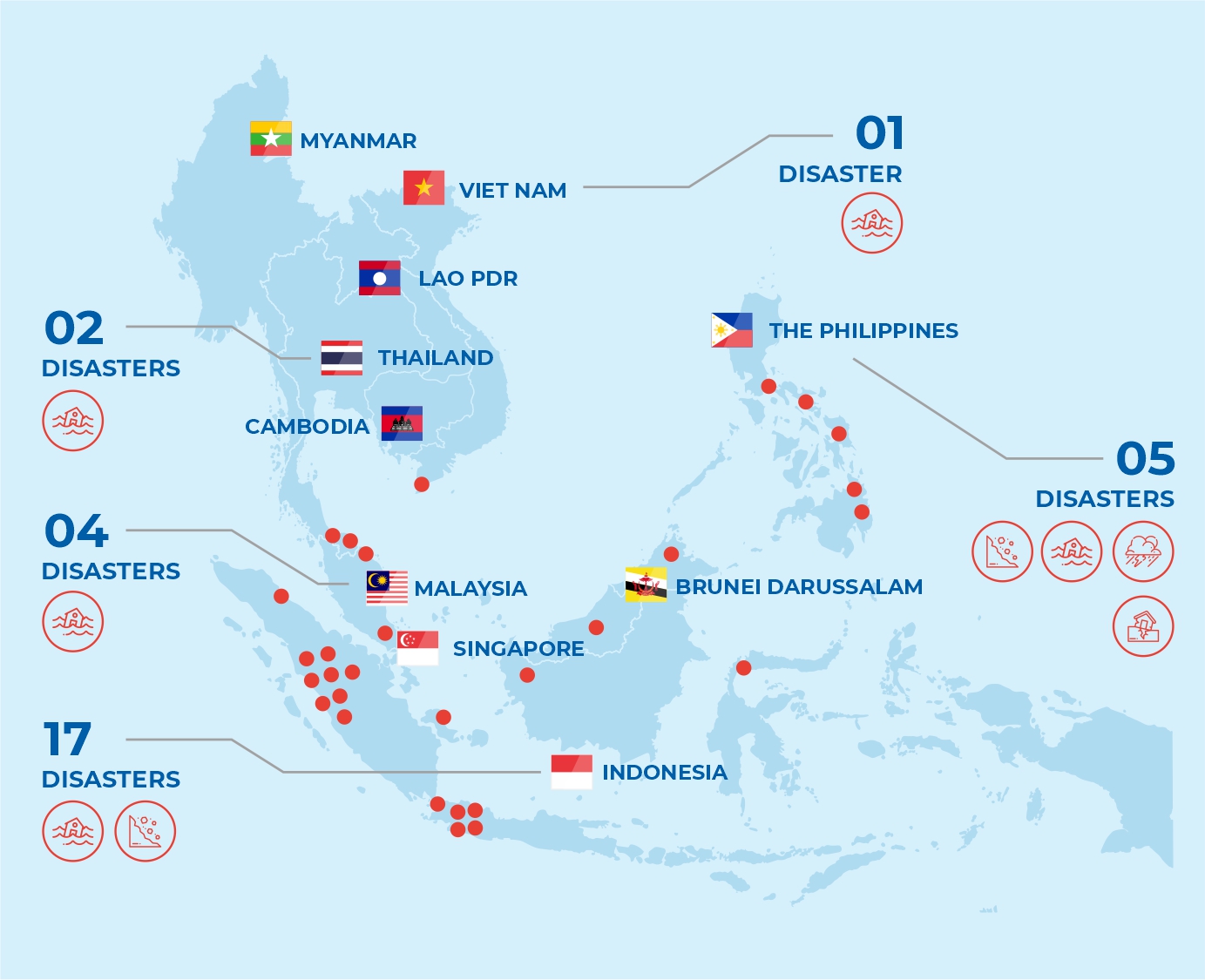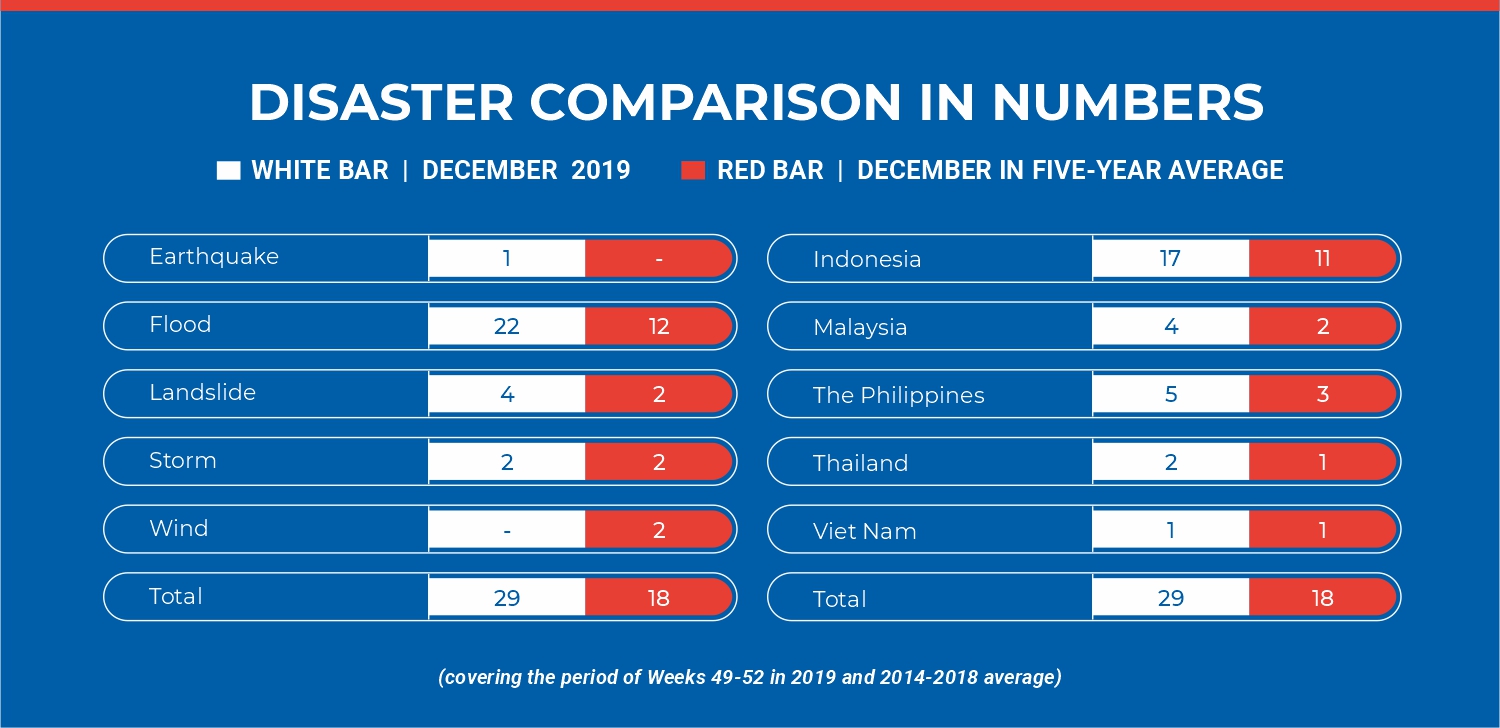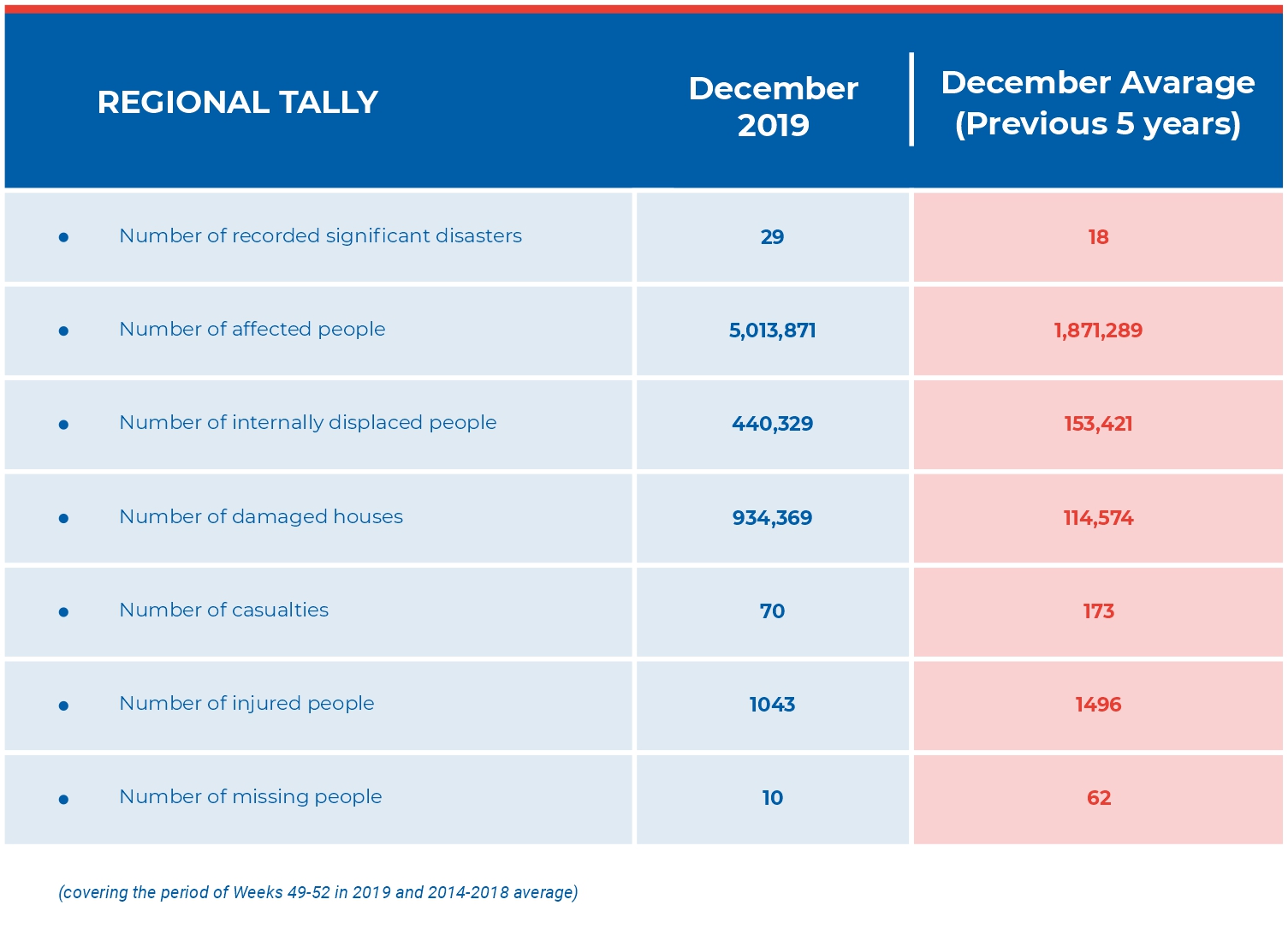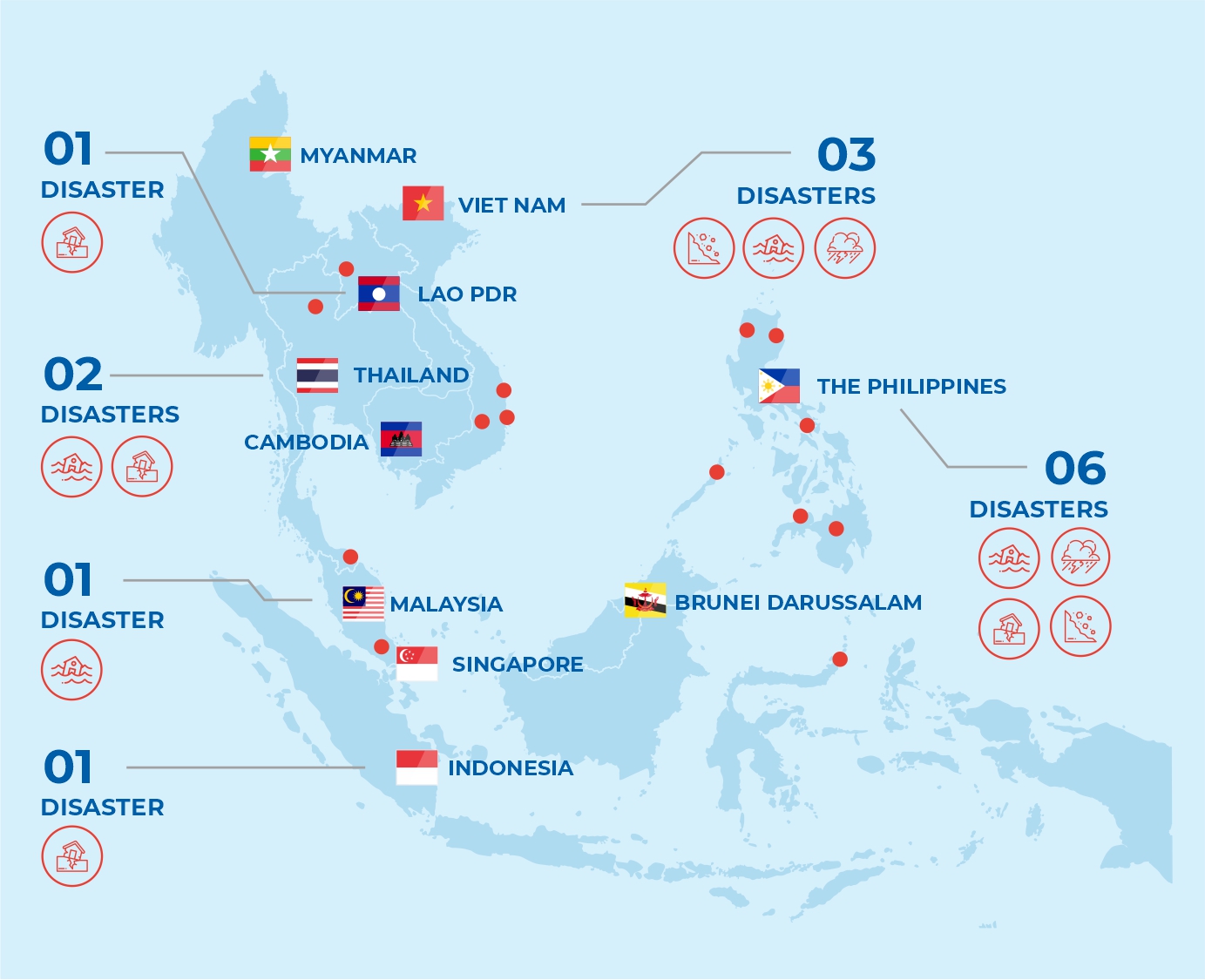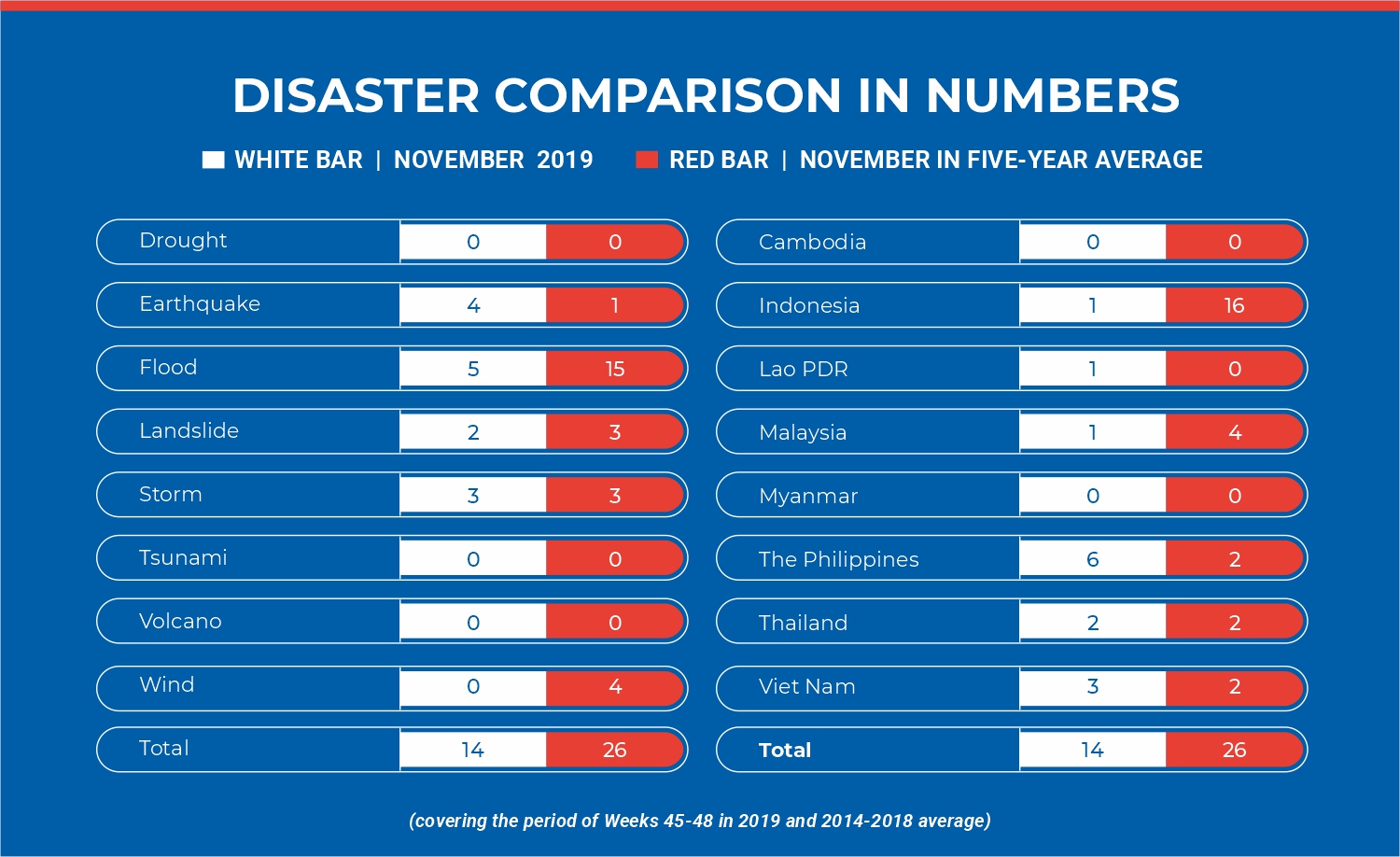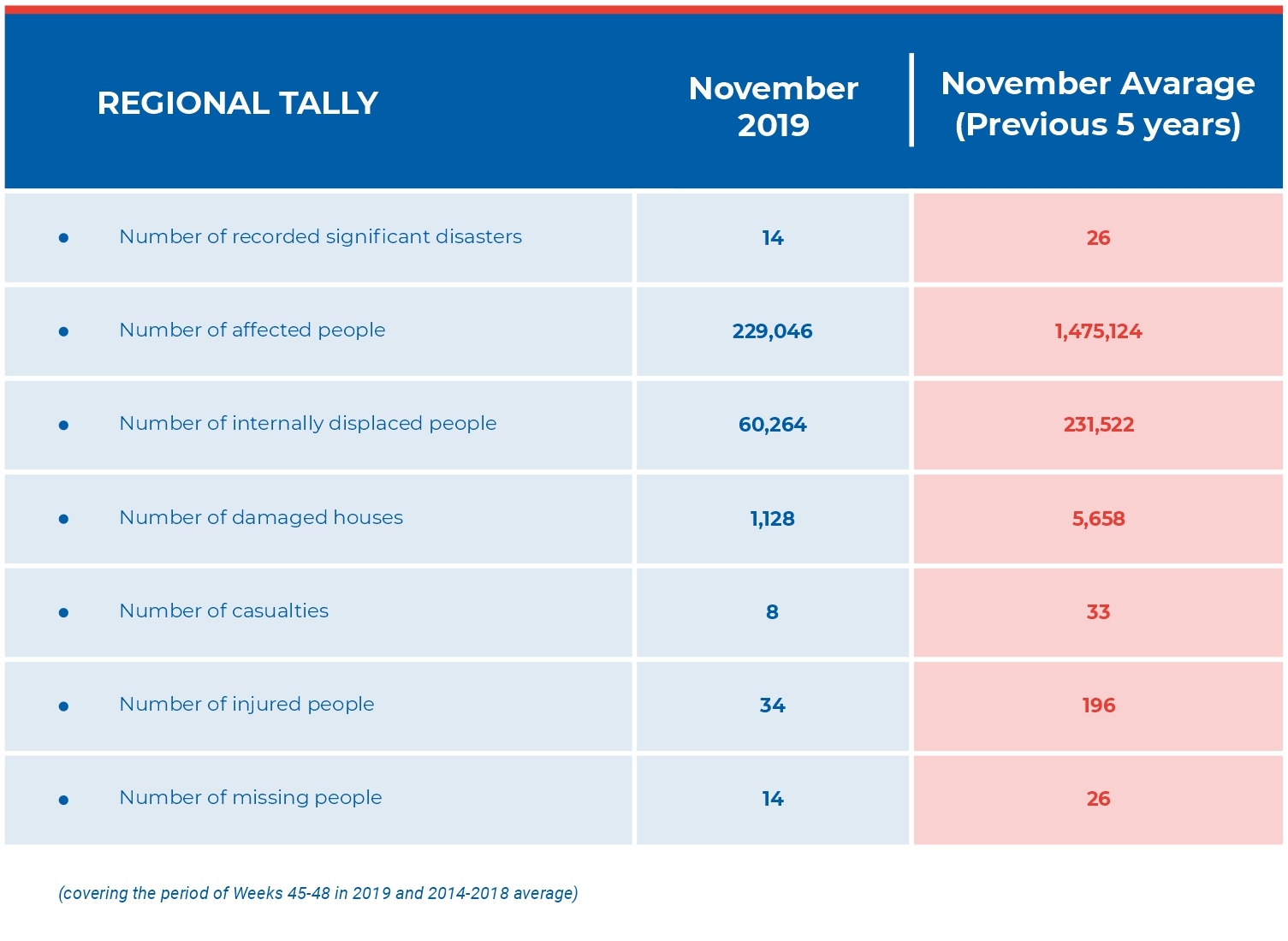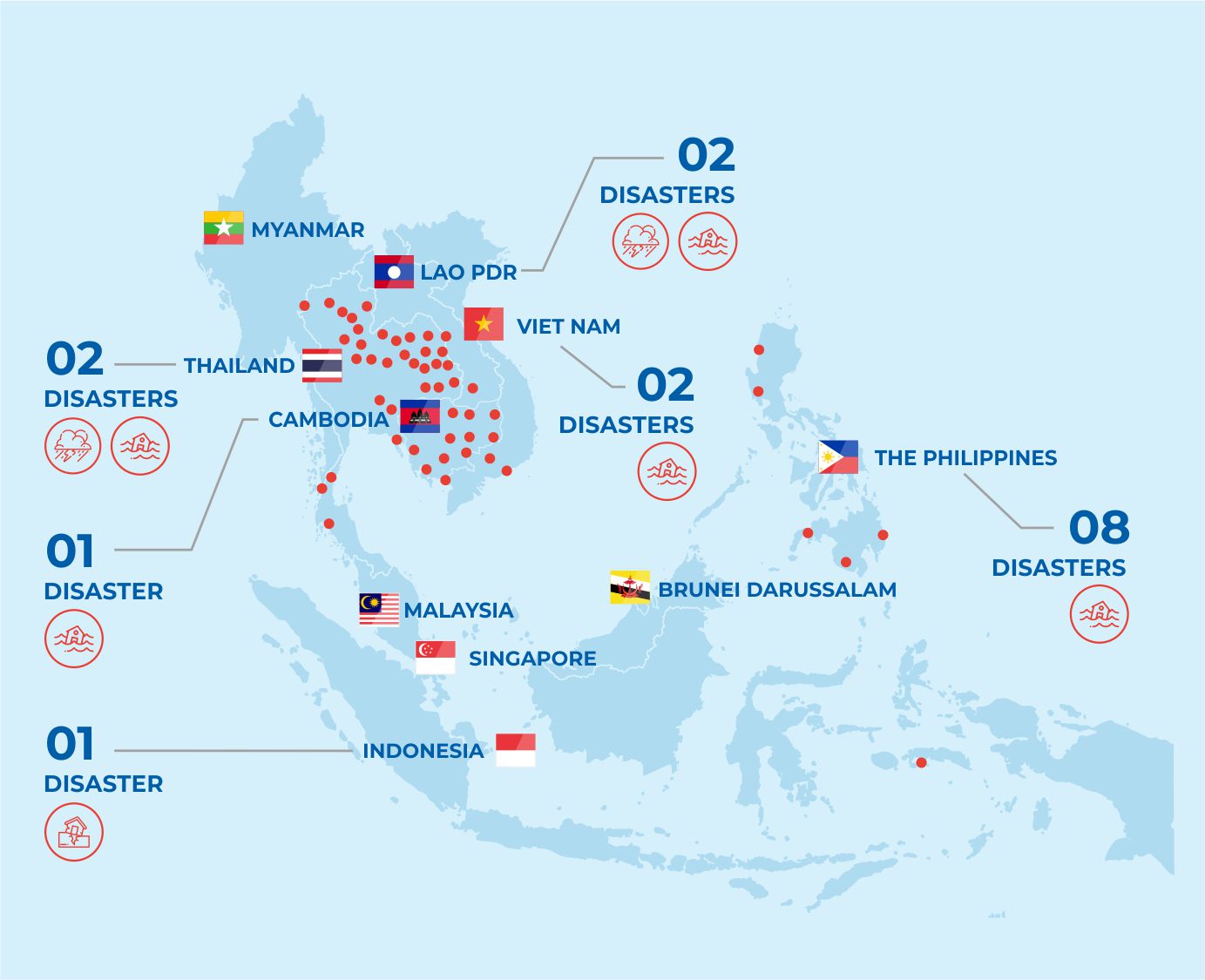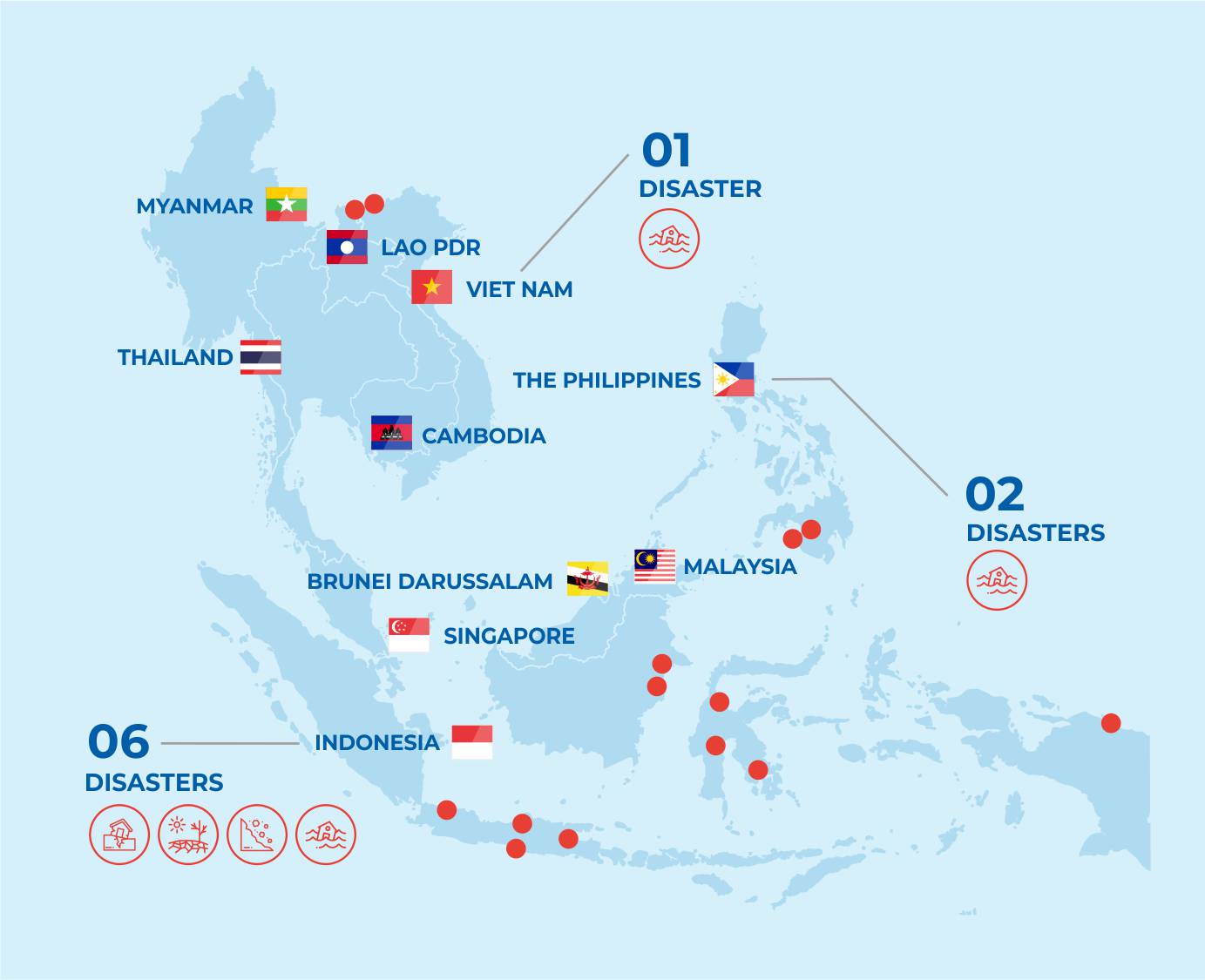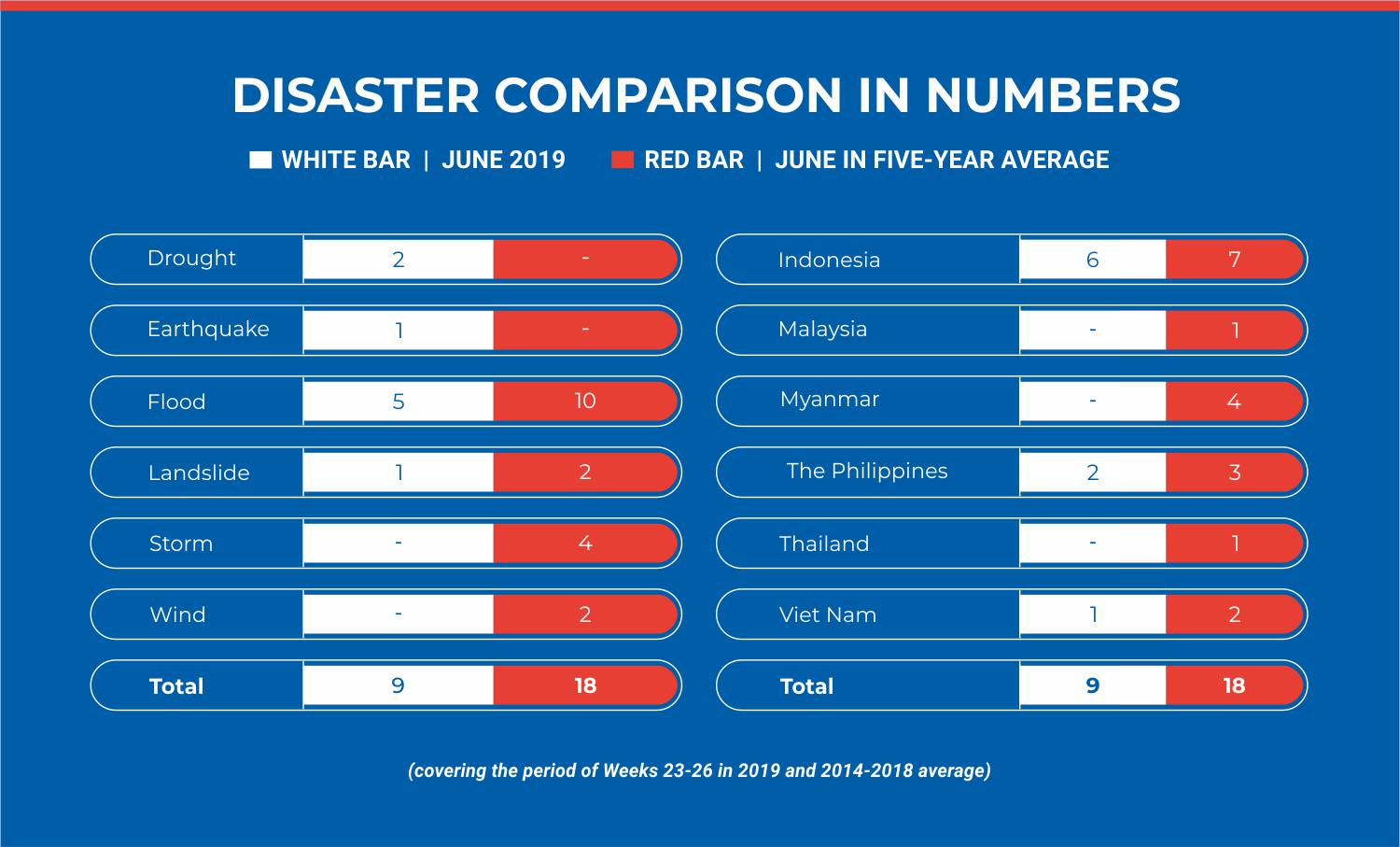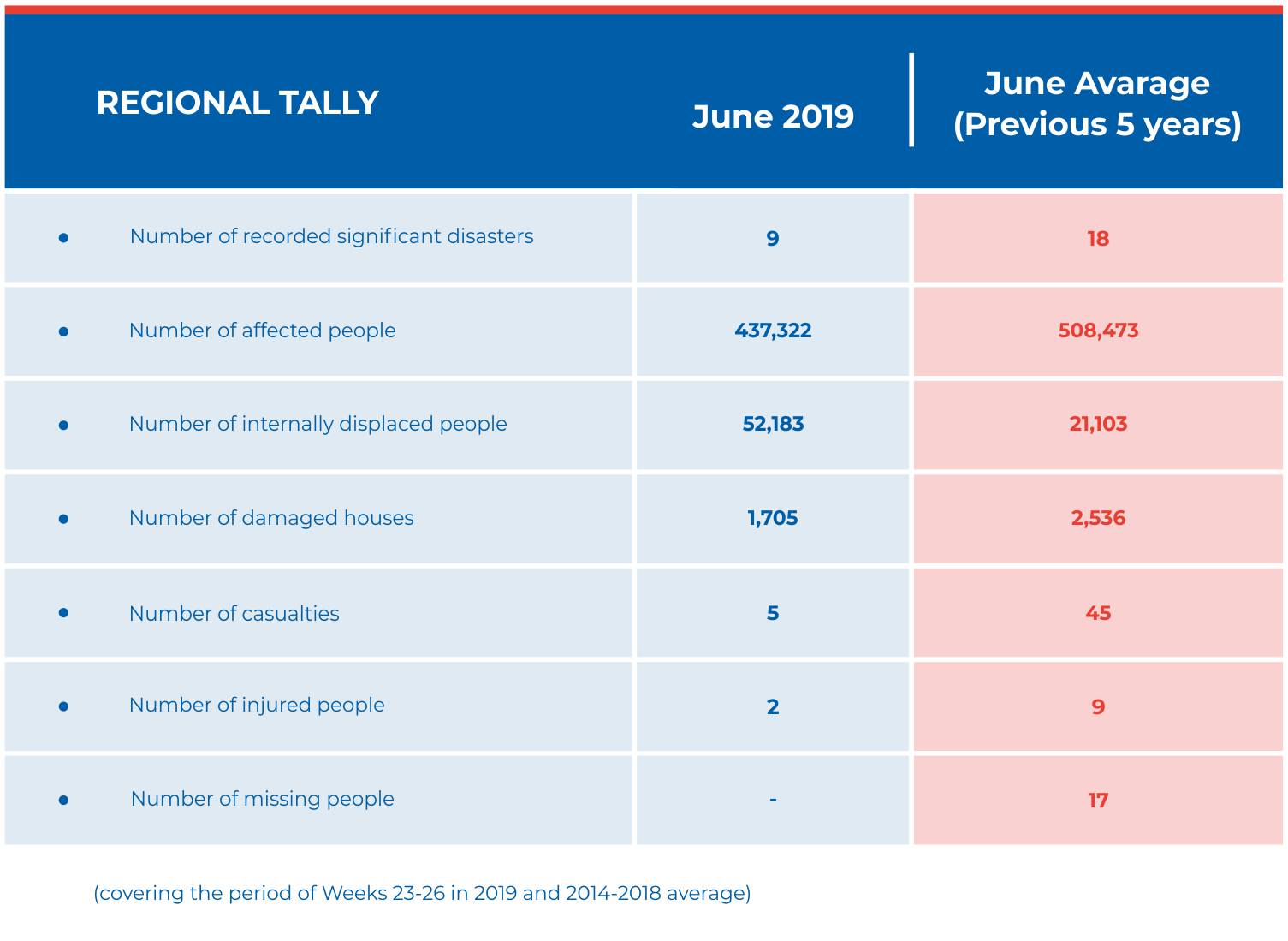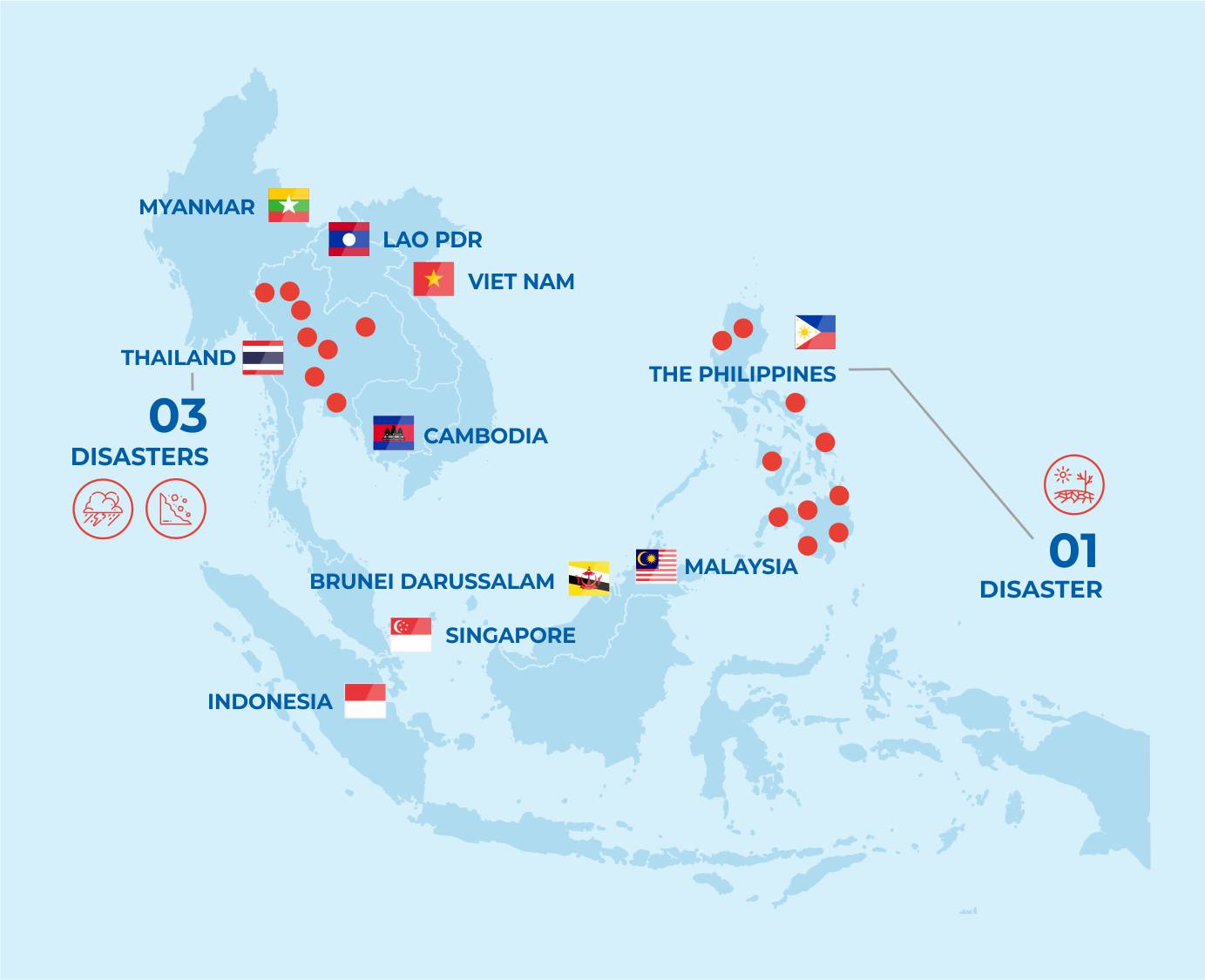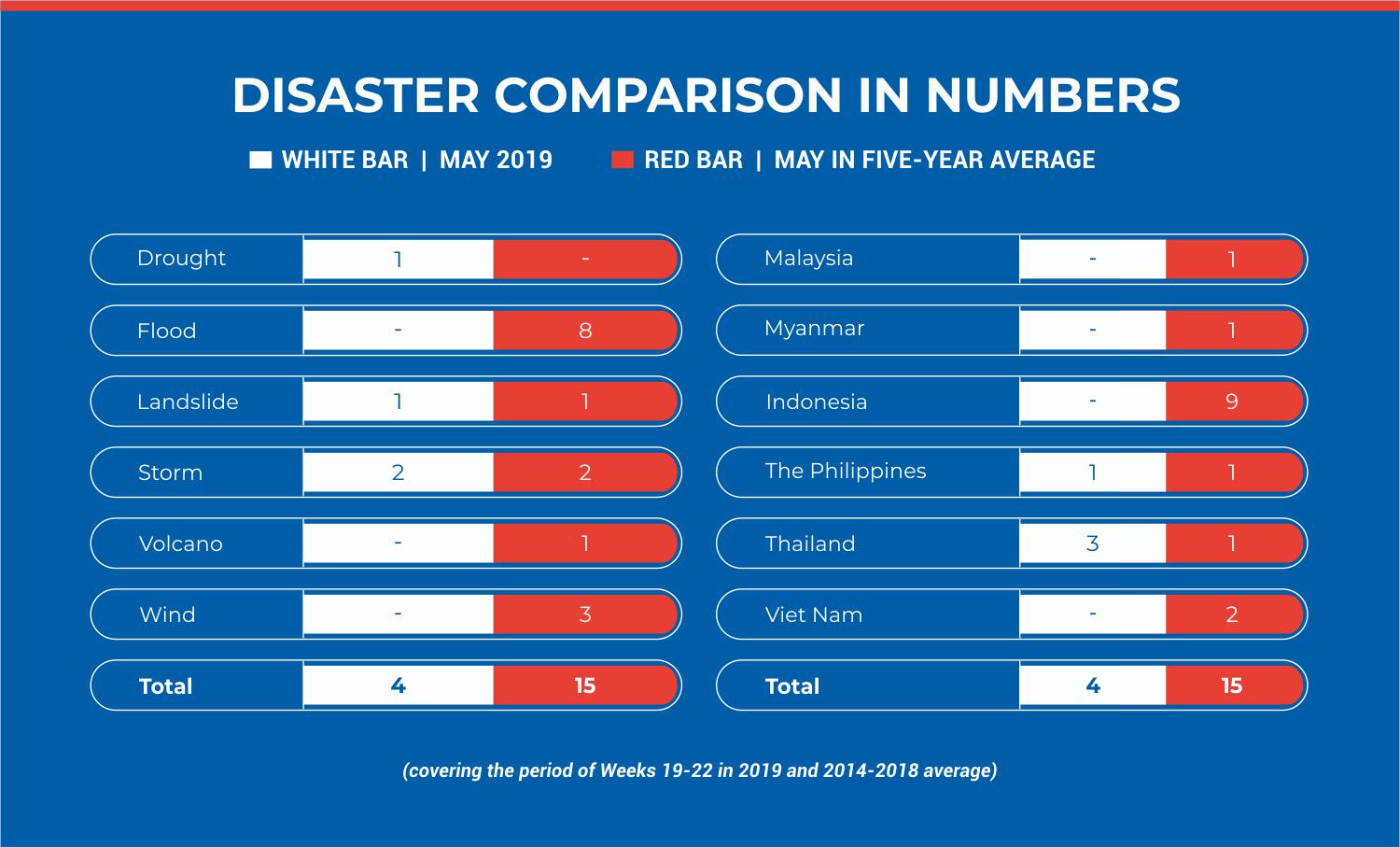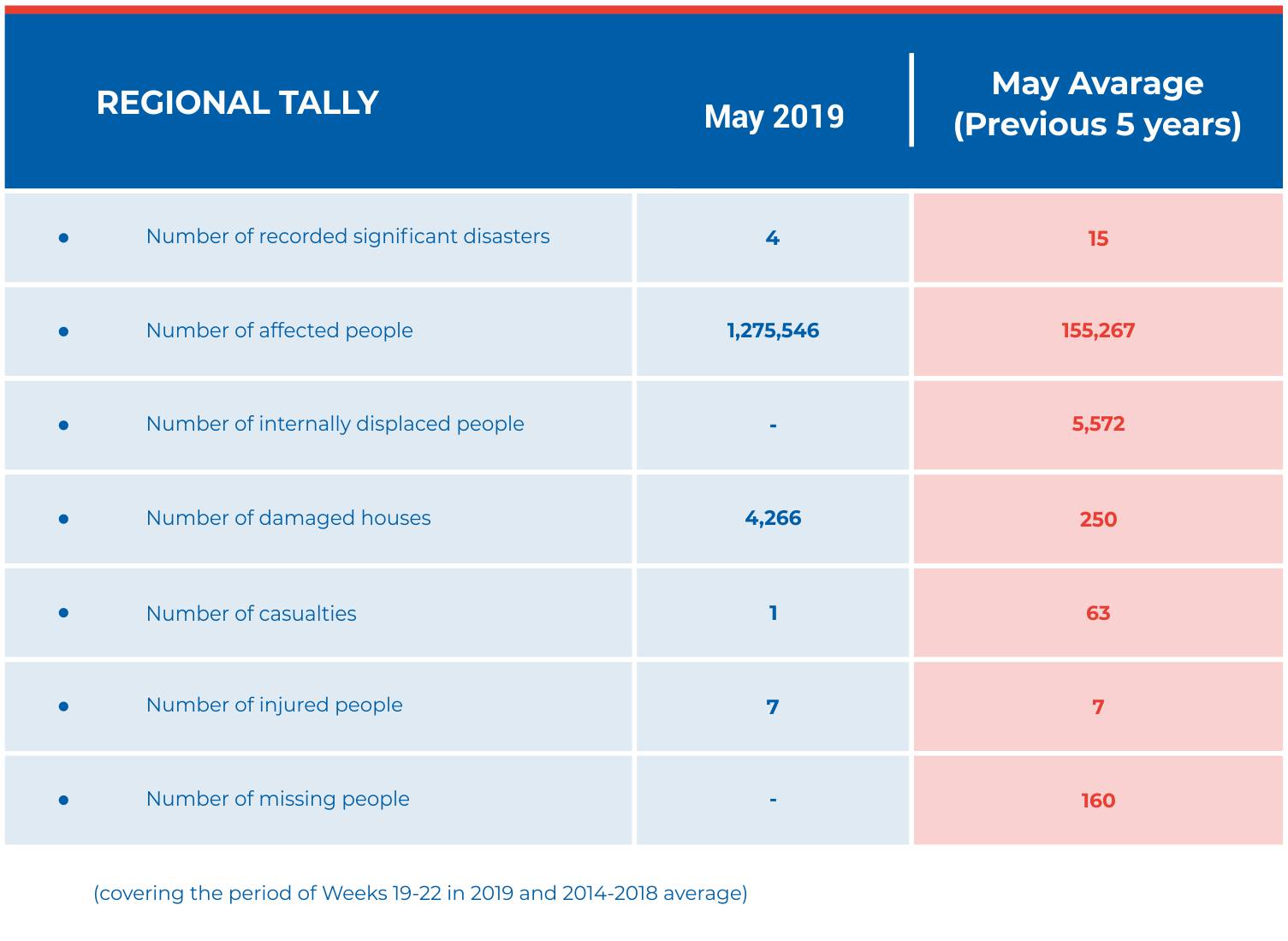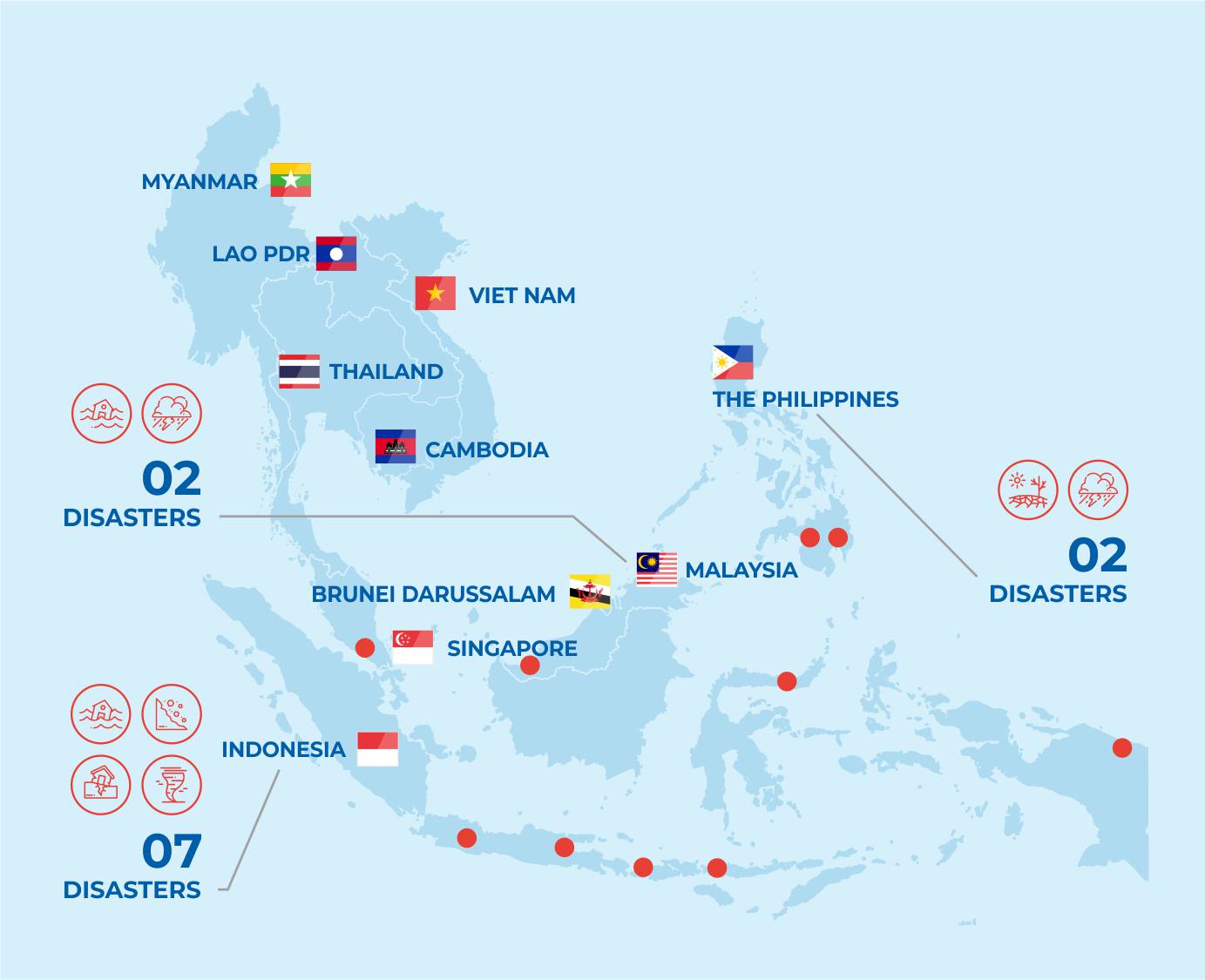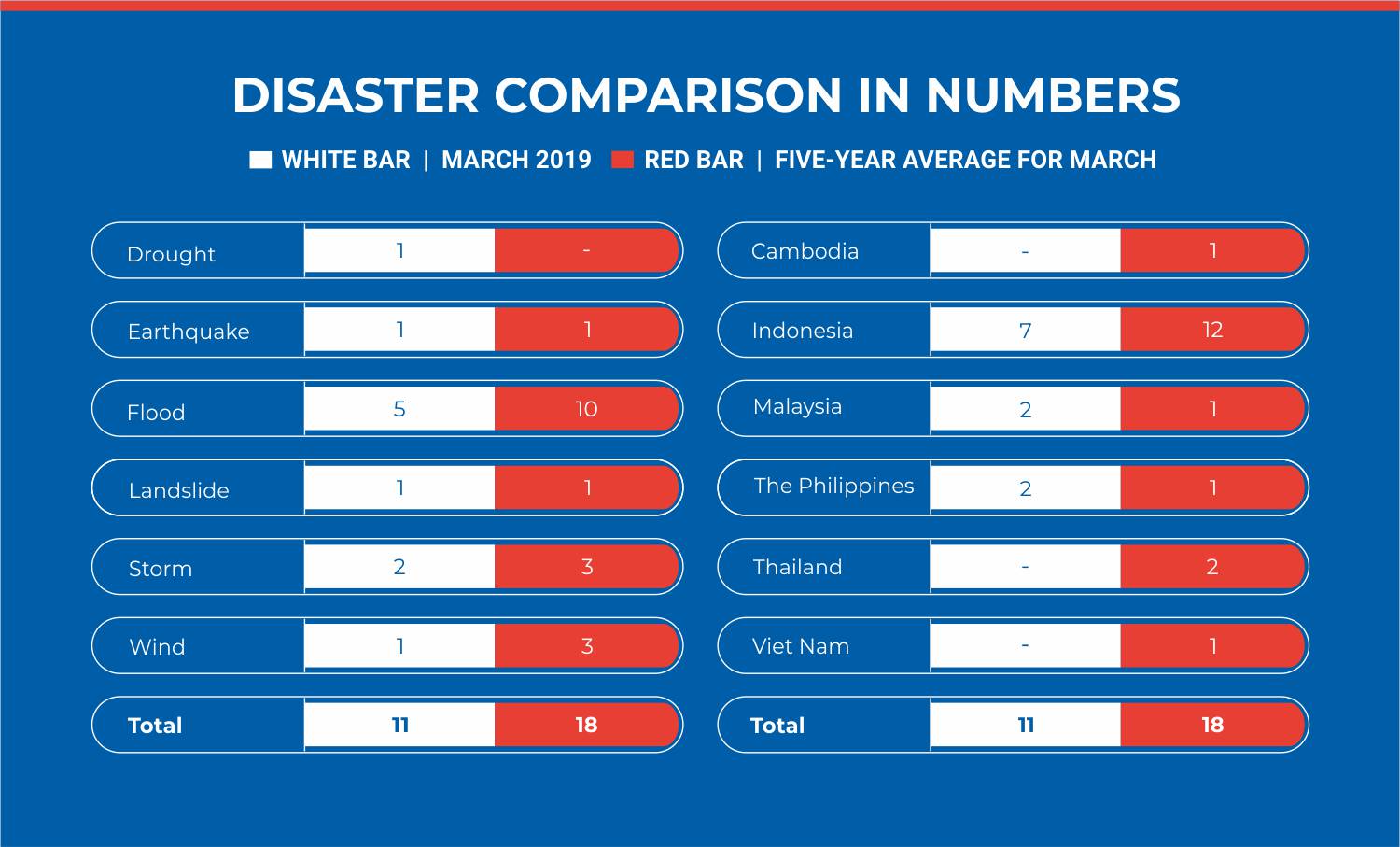Vol 57 – MONTHLY DISASTER REVIEW AND OUTLOOK 2

MONTHLY DISASTER REVIEW AND OUTLOOK
DECEMBER 2019 | DISASTER MONITORING & ANALYSIS
(DMA) UNIT, AHA CENTRE
GENERAL REVIEW OF DECEMBER 2019
December 2019 significantly shifted from the previous five-year average December disaster statistics, recording a higher number of occurrences, impact to population, and damage to houses, albeit with lower casualty rates. The number of disaster occurrences experienced a 61% increase compared to the previous five December periods, with flood events contributing the largest share. A majority of flooding events took place in Indonesia towards the end of the month when the country was experiencing strong impacts from the Madden-Julian Oscillation. Meanwhile, considerable deviations in the number of affected (168% increase from the five-year average) and displaced (187% increase from the five-year average) people and damaged houses (716% increase from the five-year average) were driven by Typhoons KAMMURI (equivalent to Category 4 hurricane at peak strength) and PHANFONE (equivalent to Category 2 hurricane at peak strength) hitting the Philippines within a three week timeframe. Combined, both typhoons are estimated to account for 79% of affected people figures, 55% of displaced people, and 97% of damaged houses reported in the last month of 2019.
On the other hand, there were notable decreases in casualty figures compared with the five-year average – with 60% decrease in dead, 30% decrease in injured, and 84% decrease in missing people. This suggests that in spite of extensive disaster impact this month, life-saving mechanisms in ASEAN Member States were effectively implemented. In terms of geophysical hazards, there were 24 recorded earthquakes of magnitude 5.0 and above, one of which was a magnitude 6.9 earthquake in the Southern Philippines, affecting hundreds of thousands of people, and contributing to more than a quarter of the displacement figures.
SEASONAL OUTLOOK
The ASEAN Specialised Meteorological Centre (ASMC) expects the Northeast Monsoon to prevail over the region until late March to early April, before transitioning towards the inter-monsoon phase. Traditionally, the Northeast Monsoon results in a dry season in the northern ASEAN region, while the rainy season persists in the southern parts of the region. In terms of main weather and climate drivers in the region, both El Niño Southern Oscillation and Indian Ocean Dipole systems are expected to be in neutral phase for the next few months, and there are signs of weakening Madden-Julian Oscillation over the coming weeks.
Above-average temperatures over most parts of the ASEAN region for the next few months is predicted by global weather and climate prediction models, with moderate to high probability of this happening. Alongside this, below-average rainfall is predicted over Myanmar and the Philippines, while there is a higher chance of above-normal rainfall around the Java Sea area and the eastern archipelago of Indonesia, which may result in flooding.
Data Sources: ASEAN Disaster Information Network, ASEAN Specialised Meteorological Centre
Written by : Lawrence Anthony Dimailig and Shahasrakiranna
DISCLAIMER
Disclaimer: AHA Centre’s estimation is based on data and information shared by National Disaster Management Organisations (NDMOs) and other relevant agencies from ASEAN Member States, international organisations and news agencies. Further information on each recorded-significant disaster, description and detail of data and information are available at: http://adinet.ahacentre.org/reports.
- Published in Monthly Disaster Outlook
Vol 57 – MONTHLY DISASTER REVIEW AND OUTLOOK

MONTHLY DISASTER REVIEW AND OUTLOOK
NOVEMBER 2019 | DISASTER MONITORING & ANALYSIS
(DMA) UNIT, AHA CENTRE
GENERAL REVIEW OF NOVEMBER 2019
The number of disaster occurrences during November 2019 was only slightly above 50% of the previous five-year average. November is the usually the month that sees the beginning of the Northeast Monsoon, bringing more rains, especially to the southern part of the ASEAN region. However, this year the positive Indian Ocean Dipole (IOD) has affected several parts of the region resulting in less rain. This is reflected by significant decreases in flooding events for the period – and the year in general – particularly in Indonesia.
The number of affected and displaced persons during the month of November also only reached about 15% and 26% compared to the previous five-year November average, while the number of damaged houses was also less than 20%. Of note is also that during the last five years, two major events (namely as Typhoon Hagupit in 2014 and Typhoon Damrey in 2017) affected more than 8 million people, and displaced more than 500,000. Most of the disasters that occurred in November 2019 were registered as minor to moderate, including Typhoon Nakri, which affected the Philippines and Viet Nam in early November, and several earthquakes in Indonesia, the Philippines, and the border of Lao PDR and Thailand. The overall decreased impact of disasters could be related to both the amount and scale of actual disasters, and also the national capacity of ASEAN Member States to respond internally.
SEASONAL OUTLOOK
According to the ASEAN Specialised Meteorological Centre (ASMC), the transition to Northeast Monsoon season began in mid-November. During this period, the northern ASEAN region typically experiences dry conditions, while the southern ASEAN region experiences rainy weather. With a surge of cool air from the northern Asian landmass expected to blow toward the Equatorial Southeast Asia region, the Mekong sub-region, South China Sea, and the surrounding areas (including Peninsular Malaysia and parts of Sumatra) can expect cooler temperatures during the outlook period. In contrast, warm conditions are forecast over the Indonesian archipelago around the Java Sea region. There is a high likelihood of above-average temperatures over most parts of the region during the December 2019 until February 2020.
In terms of rainfall outlook, there are no clear trends for the December 2019 to February 2020 season, but there is an increased chance of below-average rainfall over most parts of the region south of the equator who may experience drier-than-normal conditions in December 2019. Wetter conditions are expected over the western Maritime Continent, including central Sumatra, Peninsular Malaysia, Singapore and parts of western Borneo. Likewise, in December 2019, the Mekong sub-region and the eastern Indonesian archipelago can expect a gradual increase in hotspot activities as the dry season sets in. Based on past trends, an escalation of hotspot activities can be expected in late January and February, particularly over Thailand and Cambodia. Hotspot activities in the southern ASEAN region are expected to remain generally subdued, however isolated hotspots may emerge in Sumatra, Kalimantan and Malaysia during periods of dry weather, especially in February. Generally, above-average temperatures are likely over most parts of Southeast Asia from December 2019 to February 2020. Meanwhile, the El Niño Southern Oscillation (ENSO) monitoring system remains in “Neutral” state, and model outlooks from international centres are predicting sea surface temperature anomalies to remain at this status until early 2020.
Data Sources: ASEAN Disaster Information Network, ASEAN Specialised Meteorological Centre
Written by : Lawrence Anthony Dimailig and Shahasrakiranna
DISCLAIMER
Disclaimer: AHA Centre’s estimation is based on data and information shared by National Disaster Management Organisations (NDMOs) and other relevant agencies from ASEAN Member States, international organisations and news agencies. Further information on each recorded-significant disaster, description and detail of data and information are available at: http://adinet.ahacentre.org/reports.
- Published in Monthly Disaster Outlook
Vol 56-MONTHLY DISASTER REVIEW AND OUTLOOK

MONTHLY DISASTER REVIEW AND OUTLOOK
OCTOBER 2019 | DISASTER MONITORING & ANALYSIS
(DMA) UNIT, AHA CENTRE
GENERAL REVIEW OF OCTOBER 2019
During the month of October 2019 there were 11 reported disaster events in the ASEAN region, which registers 31% lower than the average of disaster occurrences for October over the previous five years (16). There were only 3 types of disaster events recorded in October 2019 (flood, landslide and storm), compared to 7 types recorded in the last five years for the same period. For the last five years there have been reports of drought, landslide, volcanic activity and wind events, however such disaster types were not recorded for October 2019. Also of note during this period were the comparatively low numbers of displaced, dead and injured persons, as well as damaged houses, despite the impact of the series of earthquakes that occurred in Cotabato province, southern Philippines. Three strong earthquakes with a magnitude above 6.0 rocked the province during October 2019, which aside from initial damage, also prolonged the local population’s displacement, with a majority damage experienced by residential homes (95% of the total damaged infrastructures). Earthquakes in Cotabato also claimed 24 lives from the total recorded 36 deaths for the month.
In general, this period has been dominated by hydro-meteorological events for the last five years, primarily by floods (51%) that usually affected and displaced population. This pattern is related to the tropical cyclone season in the Pacific, which brings above- normal rainfall to flood-prone areas in Southeast Asia. This was the case during October 2019, with seven of the 11 reported disasters related to flooding.
In terms of geological hazards, there were 34 seismic activities with a magnitude of 5.0 and above that occurred within October 2019, with 24 events experienced in Indonesia (BMKG), and 10 in the Philippines (PHIVOLCS) – including the three destructive earthquakes in Cotabato province. There were also three volcanic activities monitored in Indonesia, although all were categorised as Level II alert, and posed no danger to the population.
SEASONAL OUTLOOK
According to the ASEAN Specialised Meteorological Centre (ASMC), the inter-monsoon period usually transitions into the Northeast Monsoon season during November or early December. The Northeast Monsoon season will bring generally dry conditions to the northern ASEAN region, with rain to the southern ASEAN region. While rainy conditions over most of the equatorial and southern ASEAN region are expected in the next three months (November 2019 to January 2020), the rainfall is forecast to be below-average, due to the positive phase of the Indian Ocean Dipole (IOD). Amidst the dry conditions in the northern ASEAN region, there is an increased likelihood for above-average rainfall for the northernmost parts (northern parts of Laos, Myanmar and Viet Nam).
For the next 3 months the ASMC also forecasts above-average temperatures for most parts of the ASEAN region, and this may also contribute to isolated hotspot activities in the southern ASEAN region during November 2019. In terms of El Niño and La Niña, the current state remains in neutral condition, and is forecast to remain as such for the rest of 2019 and into early 2020.
Data Sources: ASEAN Disaster Information Network, ASEAN Specialised Meteorological Centre
Written by : Lawrence Anthony Dimailig, Shahasrakiranna, Lawrence Aporto, and Justin Chin Jin Jie
DISCLAIMER
Disclaimer: AHA Centre’s estimation is based on data and information shared by National Disaster Management Organisations (NDMOs) and other relevant agencies from ASEAN Member States, international organisations and news agencies. Further information on each recorded-significant disaster, description and detail of data and information are available at: http://adinet.ahacentre.org/reports.
- Published in Monthly Disaster Outlook
Vol 55-MONTHLY DISASTER REVIEW AND OUTLOOK

MONTHLY DISASTER REVIEW AND OUTLOOK
SEPTEMBER 2019 | DISASTER MONITORING & ANALYSIS
(DMA) UNIT, AHA CENTRE
GENERAL REVIEW OF SEPTEMBER 2019
During the month of September 2019, there were 16 reported disaster events throughout the ASEAN region, registering at 33% higher than the five-year average. Half of the reported events were flood events (8 in total), which is 60% higher than the five-year average. The flooding was caused by the enhanced effect of the Southwest Monsoon, due to the sequential occurrence of Tropical Storm PODUL and Tropical Depression KAJIKI in early September. These storms resulted in flooding across Lao PDR, the Philippines, Thailand, and Viet Nam. Besides the transboundary storm and flood disaster events, an M6.5 Earthquake in the last week of September struck Ambon, Indonesia, displacing more than 200,000 people.
On the other hand, general impact figures – such as the number of people affected, damaged houses, and casualties – were lower for September 2019 compared to the previous five-year average. This could be explained by the occurrence of several severe, high-impact disaster events in September 2018, including the M7.5 Earthquake and Tsunami in Central Sulawesi, Indonesia, the M6.4 Earthquake in the Philippines, and Typhoon Mangkhut which affected the northern part of the Philippines, Malaysia, and Viet Nam. In total, these events affected about 10 million people, while 2017 saw massive droughts in Indonesia, which affected around 4 million people.
During the month of September, the AHA Centre activated its Emergency Operations Centre to support the flooding event that affected six provinces in the southern part of Lao PDR. Besides sending relief items, together with the help of the Royal Malaysian Air Force (RMAF) and the United Nations Humanitarian Response Depot (UNHRD) partners, the AHA Centre also deployed its In-Country Liaison Team (ICLT) and an ASEAN-ERAT Information Management specialist to provide support in planning, training, and implementing a joint rapid needs assessment in Lao PDR. The AHA Centre also provided remote support to the National Disaster Management Organisation (NDMO) of Lao PDR for data visualisation and mapping purposes.
SEASONAL OUTLOOK
According to the ASEAN Specialised Meteorological Centre (ASMC), the inter-monsoon period will be expected to start in early October 2019 over the ASEAN region. This seasonal period is mainly characterised by light and variable winds, together with rainy conditions in the equatorial area, which can improve hotspot activities and the haze situation. This state may persist for several weeks before giving way to the Northeast Monsoon season in late November or early December.
Furthermore, the El-Nino phase will remain “neutral” at least until the end of the year. Separately, above-normal temperatures over most parts of the ASEAN region can be expected, with the northern ASEAN region to enter its traditional dry season. Meanwhile, below-normal temperatures are expected in the eastern part of the Indian Ocean, due to the positive phase of the Indian Ocean Dipole (IOD), which could also reduce the rainfall intensities in the southern ASEAN region.
Data Sources: ASEAN Disaster Information Network, ASEAN Specialised Meteorological Centre
Written by : Lawrence Anthony Dimailig, Lawrence Aporto, Shahasrakiranna, and Justin Chin Jin Jie
DISCLAIMER
Disclaimer: AHA Centre’s estimation is based on data and information shared by National Disaster Management Organisations (NDMOs) and other relevant agencies from ASEAN Member States, international organisations and news agencies. Further information on each recorded-significant disaster, description and detail of data and information are available at: http://adinet.ahacentre.org/reports.
- Published in Monthly Disaster Outlook
Vol 54-MONTHLY DISASTER REVIEW AND OUTLOOK

MONTHLY DISASTER REVIEW AND OUTLOOK
AUGUST 2019 | DISASTER MONITORING & ANALYSIS
(DMA) UNIT, AHA CENTRE
GENERAL REVIEW OF AUGUST 2019
The total number of disasters during August 2019 was almost two times higher than the previous five-year average for August, potentially due to the existence of several low pressure systems that resulted in floods. Previously, a majority of floods were caused by the Southwest Monsoon rainfall. However, the total number of affected people during this month was only about 30% of the five-year average, possibly due to the significant size of previous disasters during the month of August. For example, the 2013 Tropical Storm Trami in the Philippines, and the 2018 earthquake in Lombok, Indonesia, each affected more than 3 million people. In addition, several massive floods occurred during August 2018 in the Philippines affecting another 3 million people, as a result of several tropical storms including Soulik, Karding, and Luis. On the other hand, the casualty figures for August 2019 were much higher than the five-year averages (with the number of deaths more than three times higher), primarily as a result of the deadly landslide that occurred in Paung Township (Mon State) during the Myanmar floods that was caused by monsoonal rains.
During August 2019 there were 29 earthquakes of at least magnitude 5.0 recorded in Indonesia, Myanmar and the Philippines, but these events caused no more than minor damage. In addition, several earthquake swarms were reported during August 2019 on Java island, Indonesia, near to the Indonesian volcanic arc formed from subduction interaction between the Indo-Australian plate and the Eurasian plate.
SEASONAL OUTLOOK
According to the ASEAN Specialised Meteorological Centre (ASMC), the Southwest Monsoon season typically persists until October, meaning the northern ASEAN region will likely continue to experience the rainy season, while dry conditions should continue to prevail over the southern ASEAN region. However, inter-monsoon conditions are forecast to start in late October, and are typically characterised by light and variable winds, including an increase in shower activities over the southern ASEAN region. In addition, above-average temperatures during the next three months of 2019 are expected over most parts of the ASEAN region, except for south of the equator, where near-average or below-average temperatures will likely occur. With drier-than-usual conditions forecast to persist over many parts of the southern ASEAN region, hotspot activities in the fire-prone Indonesian provinces of Sumatra and Kalimantan may escalate, and could lead to an increased risk of transboundary haze occurrence. While in the northern ASEAN region, hotspot activities are expected to remain generally subdued due to rainy weather.
To further develop and strengthen coordination to deal with the transboundary natural hazards in the ASEAN region – such as floods, droughts, and tropical cyclones – the AHA Centre participated in the 8th ASEAN Committee on Disaster Management (ACDM) Working Group on Risk Assessment and Awareness (WG RAA) meeting held back to back with the Expert Dialogue on Scaling up Regional Cooperation in Multi-hazard Early Warning Systems in Asia-Pacific. This took place on the last week of August 2019 in Bangkok, Thailand, organised by the ASEAN Secretariat and co-organised by the United Nations Economic and Social Commission for Asia and the Pacific (UNESCAP).
Data Sources: ASEAN Disaster Information Network, ASEAN Specialised Meteorological Centre
Written by : Lawrence Anthony Dimailig, Shahasrakiranna, and Justin Chin Jin Jie
DISCLAIMER
Disclaimer: AHA Centre’s estimation is based on data and information shared by National Disaster Management Organisations (NDMOs) and other relevant agencies from ASEAN Member States, international organisations and news agencies. Further information on each recorded-significant disaster, description and detail of data and information are available at: http://adinet.ahacentre.org/reports.
- Published in Monthly Disaster Outlook
Vol 53-MONTHLY DISASTER REVIEW AND OUTLOOK

MONTHLY DISASTER REVIEW AND OUTLOOK
JULY 2019 | DISASTER MONITORING & ANALYSIS
(DMA) UNIT, AHA CENTRE
GENERAL OVERVIEW OF JULY 2019
During the month of July 2019, as many as 27 disasters were reported within the region. This figure is 29% higher than the previous five-year average number of disaster occurrences for July – with an observable spike in the number of earthquake and landslide occurrences. However, all other figures are lower than the respective five-year average, except for numbers of injured persons. The number of injured people increased by 64% due to the M7.2 earthquake that struck North Maluku during the second week of July. In general, the lower disaster impact figures for July this year, in comparison to the average during the last five years, can be attributed primarily to the magnitude of disaster occurrences. In July 2014, Typhoon Ramassun battered the Philippines and Viet Nam, Myanmar was heavily flooded in 2015, and drought significantly impacted Myanmar and the Philippines during 2018. These major disaster events affected between 1.7 million to 4.5 million people, displaced hundreds of thousands, and resulted in mass casualties. This year, only minor and moderate disaster events have occurred, resulting in only impact numbers of 32% of the five-year average affected people, and 10% of the five-year average internally displaced people.
There were 46 earthquakes of at least magnitude 5.0 recorded in Indonesia and the Philippines during the month. July 2019 was characterised by quite a number of earthquake events that resulted in minor to significant damages. Collectively, these earthquake events contributed to at least 79% in this month’s casualties (dead, injured, and missing), had a 65% share in causing internal displacement, and caused 92% of damaged houses.
SEASONAL OUTLOOK
Rainfall data for the month of July 2019 indicates near to above normal rainfall conditions were experienced in Lao PDR, Myanmar, Singapore, Thailand, Viet Nam, and most parts of Malaysia, the Philippines, and West Papua in Indonesia. Meanwhile, below normal rainfall conditions were recorded over eastern Indonesia and portions of southern Malaysia. Similar conditions are expected to persist as the impact of Southwest Monsoon continues in the region. For the next three months, the ASEAN Specialised Meteorological Centre (ASMC) expects generally above-normal rainfall conditions in the southern parts of Cambodia, Myanmar, Thailand, and Viet Nam, while generally below-normal rainfall conditions are predicted over the southern ASEAN region and over southern Philippines. In addition, the Indian Ocean Dipole (IOD) is currently showing positive values, and is expected to persist into the 3rd quarter of 2019. A positive IOD can lead to below-normal rainfall conditions over Singapore and nearby areas, which will contribute further to the current drier conditions. Coupled with the effects of the Southwest Monsoon, there is a potential for an escalation of hotspot activities in the southern ASEAN region, which may lead to an increase in the risk of transboundary haze occurrence.
The potential for recurrence of flooding in the Mekong sub-region, and the continuation of drought in the southern ASEAN region, requires readiness in terms of monitoring and response. In line with this, the AHA Centre joined the National Disaster Risk Reduction and Management Council, the Office of Civil Defense, and the Pacific Disaster Center during the launch of PhilAWARE and National Disaster Preparedness Baseline Assessment in the Philippines. These initiatives aim to increase preparedness capacities of the Philippines, including monitoring hazards within its jurisdiction. In addition, the AHA Centre also conducted the Pilot ASEAN Humanitarian Civil-Military Coordination Course, and participated in the ASEAN Defence Ministers Meeting (ADMM) Plus Humanitarian Assistance and Disaster Response Communications and Staff Exercises. These events contribute to the readiness of the Centre in coordinating military assistance during emergency response.
Data Sources: ASEAN Disaster Information Network, ASEAN Specialised Meteorological Centre
Written by : Lawrence Anthony Dimailig & Shahasrakiranna
DISCLAIMER
Disclaimer: AHA Centre’s estimation is based on data and information shared by National Disaster Management Organisations (NDMOs) and other relevant agencies from ASEAN Member States, international organisations and news agencies. Further information on each recorded-significant disaster, description and detail of data and information are available at: http://adinet.ahacentre.org/reports.
- Published in Monthly Disaster Outlook
Vol 52-MONTHLY DISASTER REVIEW AND OUTLOOK

MONTHLY DISASTER REVIEW AND OUTLOOK
JUNE 2019 | DISASTER MONITORING & ANALYSIS
(DMA) UNIT, AHA CENTRE
GENERAL OVERVIEW OF JUNE 2019
Disaster occurrences in June 2019 amounted to only half of the average for June across the previous five years. Interestingly, while the impact of Southwest Monsoon in the region brings traditionally wet conditions in most ASEAN Member States, during this month the numbers of flooding, storms, and wind-related disturbances recorded were significantly less than those of the previous five years. Meanwhile, reported drought incidents rose significantly when compared with the last five years. These conditions may have been influenced by the borderline El Niño currently being experienced in the region, which resulted to lower-than-normal rainfall and higher-than-normal temperature. On the other hand, it is also important not to discount the possibility that the increase in drought reports may be due to developments in drought monitoring and reporting processes and technology across the region.
While the number of disaster occurrences are significantly lower than the previous five-year average, the number of reported affected people remained similar at 86%. This suggests that disaster occurrences in June 2019 had a higher impact than many incidents across the past five years. In addition, the reported number of internally displaced people (IDP) is 2.5 times higher than the previous five-year average. The high number of IDPs was driven by the reported sudden change of atmospheric conditions in the southern Philippines, which experienced continuous heavy rains after being devastated by drought for weeks. On the other hand, damaged houses and casualties recorded significantly lower numbers than the previous five-year average, which may be attributable to decreased flooding and rain-induced landslides – key drivers of high numbers of damaged houses and casualties, in addition to earthquakes. June 2019 recorded 32 earthquakes of magnitude 5.0 and above, and while there was one earthquake in Indonesia that affected people and damaged houses, the impact was still considered minor.
SEASONAL OUTLOOK
The ASEAN Specialised Meteorological Centre (ASMC) predicts the prevailing Southwest Monsoon to continue until October 2019. As a result, general continuity of rainy conditions in the northern ASEAN region and dry conditions in the southern ASEAN region can be expected. In addition, above-normal rainfall is forecast in several parts of Cambodia, Myanmar, Thailand and Viet Nam, while above-normal temperatures are likely in most parts of the region except for southern parts of ASEAN. The El Niño Southern Oscillation monitoring system remains in the “Watch” status for the region, which suggests borderline El Niño conditions. Looking forward, overall signs of future El Niño development have weakened, however, model outlooks of international centres still show a wide spread of outcomes ranging from neutral conditions to moderate El Niño.
Data Sources: ASEAN Disaster Information Network, ASEAN Specialised Meteorological Centre
Written by : Lawrence Anthony Dimailig & Shahasrakiranna
DISCLAIMER
Disclaimer: AHA Centre’s estimation is based on data and information shared by National Disaster Management Organisations (NDMOs) and other relevant agencies from ASEAN Member States, international organisations and news agencies. Further information on each recorded-significant disaster, description and detail of data and information are available at: http://adinet.ahacentre.org/reports.
- Published in Monthly Disaster Outlook
Vol 51-MONTHLY DISASTER REVIEW AND OUTLOOK

MONTHLY DISASTER REVIEW AND OUTLOOK
MAY 2019 | DISASTER MONITORING & ANALYSIS
(DMA) UNIT, AHA CENTRE
GENERAL OVERVIEW OF MAY 2019
Only four disaster occurrences were recorded in the ASEAN region during the month of May 2019 – all of which are hydro-meteo-climatological in nature. While the number of disaster occurrences registered was only around 27% compared to May’s previous five-year average, the number of reported affected people and damaged houses, were significantly above average, as much as 8 and 17 times respectively. The results are due to the drought and other related effects of El Niño in the Philippines (for affected people), and the combination of several atmospheric disturbances that brought storms and a rain-induced landslide in Thailand (for damaged houses). The geographic extent of drought conditions saw widespread impact in the Philippines, with 10 of the 17 regions in the country reported to have been affected. This formed a key driver for high numbers of affected people. In the case of Thailand, heavy rainfall conditions throughout the country were influenced by the strengthening of the Southwest Monsoon, coupled by multiple low pressure cells. This resulted in continuous heavy rainfall which eventually overwhelmed soil water absorption capacity, thereby resulting in rain-induced landslides. The combination of storms and rain-induced landslides resulted in higher numbers of damaged houses.
Generally, there were no fatalities or significant damages directly caused by geophysical hazards during the month. Nineteen earthquakes of magnitude 5.0 and above were recorded in Indonesia, Myanmar, and the Philippines, while four volcanoes in Indonesia are still under increased monitoring. In addition, an eruption at Mt. Agung in Indonesia was reported during the month, with several areas affected by ash rain. Fortunately, most of the population are located outside the hazard zones, and hence no evacuations were triggered.
SEASONAL OUTLOOK
The Southwest Monsoon is normally experienced by the ASEAN region during June. Traditionally, Southwest Monsoon results in the rainy season through the northern part of the region, while the southern parts experience a dry period. Meanwhile, the ASEAN Specialised Meteorological Centre expects the borderline El Niño conditions in the region, which have been observed since the last quarter of 2018, to continue until August 2019. Also, the Indian Ocean Dipole is expected to develop into its positive state, with lower than average sea surface temperatures. As a result, while rainy conditions are expected across most of the region, the amount of rainfall may potentially be below normal levels. There are, however, several areas that may experience wetter-than-normal conditions – specifically, Western and Southern Myanmar, and parts of Sumatra, Northern Sulawesi, Moluccas, and Papua in Indonesia. Finally, above-normal temperatures are expected in most of Central and Eastern Southeast Asia, including parts of Peninsular Malaysia, Singapore, and Central and Western Indonesia during the next 3 months.
As the Southwest Monsoon is predicted to be in full effect throughout the region across the next few weeks, the occurrence of tropical cyclones over the Bay of Bengal and Western Pacific are expected. This puts the Mekong sub-region and the Philippines at-risk. To support such anticipated events, the AHA Centre is finalising its preparations for the launch of the Disaster Emergency Logistics System for ASEAN (DELSA) Satellite Warehouses in the Philippines and in Thailand, that aims to improve the delivery of relief resources to Member States. For longer-term impact, the AHA Centre, in partnership with the Pacific Disaster Center, aims to gain a deeper understanding of disaster risk of countries in the ASEAN region through the National Disaster Preparedness Baseline Assessment (NDPBA). With a more detailed assessment, the NDPBA is expected to identify specific risk elements for increased investment focus, in order to increase resilience. The NDPBA has been launched in Viet Nam, and has scheduled upcoming launches in Indonesia and the Philippines. Lastly, the AHA Centre will explore a new concept in Disaster Risk Reduction through the upcoming 3rd Asia Pacific Dialogue Platform on Forecast-based Financing (FbF). FbF is a programme that enables access to humanitarian funding for early action based on in-depth forecast information and risk analysis. The goal of FbF is to anticipate disasters, prevent their impact if possible, and reduce impact on human populations.
Data Sources: ASEAN Disaster Information Network, ASEAN Specialised Meteorological Centre
Written by : Lawrence Anthony Dimailig & Shahasrakiranna
DISCLAIMER
Disclaimer: AHA Centre’s estimation is based on data and information shared by National Disaster Management Organisations (NDMOs) and other relevant agencies from ASEAN Member States, international organisations and news agencies. Further information on each recorded-significant disaster, description and detail of data and information are available at: http://adinet.ahacentre.org/reports.
- Published in Monthly Disaster Outlook
Vol 50-MONTHLY DISASTER REVIEW AND OUTLOOK

MONTHLY DISASTER REVIEW AND OUTLOOK
APRIL 2019 | DISASTER MONITORING & ANALYSIS
(DMA) UNIT, AHA CENTRE
GENERAL OVERVIEW OF APRIL 2019
April began 2019’s second quarter by continuing the trend of lower disaster occurrences compared to the average of the five previous years, with the number of people affected by disaster reaching only 11% of the previous five-year average. This significant difference is primarily caused by an extreme event during 2016 that skews the five-year average – namely the 2016 drought in Cambodia that affected 2.5 million people. On the other hand, April 2019 witnessed higher-than-average displacement, house damage, and casualty figures. A majority of population displacement during April was due to widespread flooding and rain-induced landslides in Indonesia and Myanmar. Increased atmospheric activity, due to the inter-monsoon period, resulted in scattered rain showers across the region, while the Madden-Julian Oscillation further enhanced the duration and amount of rainfall in Indonesia during the last week of the month. Meanwhile, a majority of house damage was due to a hailstorm in Central Myanmar, that saw hailstones as large as golf balls raining down on homes made from light materials. Three disaster events significantly influenced the rise in casualties across the region – namely flooding, followed by a rain-induced landslide in Bengkulu Province, Indonesia, and the magnitude 6.1 earthquake in Central Luzon, the Philippines.
Geophysical activity registered 56 earthquakes of magnitude 5.0 and above during April 2019. Three of these earthquakes resulted in significant impact to people and structures, seeing them classified in disaster statistics – a 6.8M in Central Sulawesi, Indonesia (close to ground zero for the devastating 7.5M earthquake that triggered a tsunami and liquefaction in 2018), and back-to-back 6.1M and 6.5M earthquakes in Central Luzon and Eastern Samar, the Philippines. Lastly, there were four volcanoes, all in Indonesia, being monitored due to increased activities – Mount Agung, Mount Karangetang, and Mount Soputan, all at Alert Level 3, and Mount Sinabung, which is at Alert Level 4, the highest alert level for volcanoes in Indonesia.
SEASONAL OUTLOOK
The inter-monsoon period is expected to last until June, upon which the Southwest Monsoon will become dominant in the region. During this transition, a northward shift of monsoon rain bands will be observed. While rainy conditions are expected in the northern ASEAN region, the ASEAN Specialised Meteorological Centre forecasts generally below-average rainfall. However, the gradual increase in rain shower activities is expected to subdue hotspot activities and improve haze conditions in the Mekong sub-region. Meanwhile, drier weather conditions are expected to slowly increase across the southern ASEAN region, particularly in Indonesia. Seasonal models tend to exempt the southern ASEAN region from the warmer temperatures expected in most of the region during the second quarter of the year.
As part of its preparatory activities for the rainy season in the northern ASEAN region and dry conditions in the southern ASEAN region, the AHA Centre will conduct a table-top exercise to test its Emergency Response Organisation procedures for responding to any disaster within the region. Alongside this, connectivity testing with respective Emergency Operations Centres (EOC) of each ASEAN Member State is also being planned. Finally, in cooperation with the Pacific Disaster Center (PDC Global), a DisasterAWARE Multi-Hazard Monitoring Platform is planned to be established in Brunei Darussalam, Cambodia, Lao PDR, and the Philippines. DisasterAWARE is a powerful and reliable early warning and multi-hazard monitoring platform, that supports disaster management and emergency response by providing early warning, multi-hazard monitoring, impact assessment modelling, and geospatial data. The Centre has been using the regionally-adapted version of DisasterAWARE, (Disaster Monitoring and Response System – DMRS), in its daily operations for many years. At present, the AHA Centre and PDC Global are working with Myanmar to develop capacity and capability to utilise the DMRS, while several ASEAN Member States already utilise their own versions of DisasterAWARE – including Indonesia, Thailand, and Viet Nam.
Data Sources: ASEAN Disaster Information Network, ASEAN Specialised Meteorological Centre
Written by : Lawrence Anthony Dimailig, Shahasrakiranna
DISCLAIMER
Disclaimer: AHA Centre’s estimation is based on data and information shared by National Disaster Management Organisations (NDMOs) and other relevant agencies from ASEAN Member States, international organisations and news agencies. Further information on each recorded-significant disaster, description and detail of data and information are available at: http://adinet.ahacentre.org/reports.
- Published in Monthly Disaster Outlook
Vol 49-MONTHLY DISASTER REVIEW AND OUTLOOK

MONTHLY DISASTER REVIEW AND OUTLOOK
MARCH 2019 | DISASTER MONITORING & ANALYSIS
(DMA) UNIT, AHA CENTRE
GENERAL OVERVIEW OF MARCH 2019
March ended the first quarter of 2019 continuing the trend of lower disaster occurrences compared to its five-year average. This month registered 61% of its five-year average number of disaster occurrences, similar to the statistics of January 2019. However, the number of affected persons was more than 10 times the average for March, and the number of casualties is more than 13 times more than the previous 5 years on average. These considerable differences were driven by two significant events – the drought in North Cotabato, Philippines and the flooding in Sentani, Indonesia. 60% of this month’s affected population is attributed to the Philippines drought, particularly due to the drought’s extensive geographic coverage. On the other hand, 92% of this month’s casualties resulted from the flooding and landslide in Sentani, Indonesia. The primary factor for these figures can be attributed to the timing of the flash flood, which happened at night while most of the residents were sleeping in their homes. This highlights the importance of availability, accessibility, and utilisation of early warning information to drive early action.
Geophysical disasters decreased in March compared to the previous 2 months, with only 23 earthquakes of magnitude 5.0 and above recorded in the region. Of these recorded earthquakes, only one resulted in loss of life. A shallow earthquake with magnitude 5.4 struck north of Selong City in East Lombok Regency, Indonesia. This resulted in damage and collapse of structures in the area, as well as falling rocks and debris at the nearby Tiu Kelep Waterfall in North Lombok Regency, which resulted in the deaths of two tourists visiting the site. This highlights the nature and need for multi-disciplinary and cross-cutting approaches in disaster management
SEASONAL OUTLOOK
The ASEAN Specialised Meteorological Centre reports the end of the Northeast Monsoon, and that onset of the inter-monsoon period is taking place. This is the transition phase between the Northeast and Southwest Monsoons, which is characterised by increased occurrence of scattered rain showers in the region. While seasonal forecast models point to a general increase in rainfall frequency, and a geographic expansion of rain showers, precipitation on the other hand ranges from normal in the Philippines to below-normal in eastern Indonesia and the northern ASEAN region. While the amount of rainfall may not be considerably large, the increase in exposure may still trigger flooding and rain-induced landslides.
Statistically, large-scale disasters that require regional-level response occur during the second half of the year. At the end of 2019’s first quarter, the AHA Centre is wrapping up its preparatory activities for emergency response and other events. This includes the updating and preparation of Common Operational Datasets, 11th ASEAN-ERAT Induction Course, the preparation for the launch of the DELSA satellite warehouses and many more. Activities such as these help prepare the AHA Centre, and the region, to respond to disaster whenever and wherever it may strike.
Data Sources: ASEAN Disaster Information Network, ASEAN Specialised Meteorological Centre
Written by : Lawrence Anthony Dimailig
DISCLAIMER
Disclaimer: AHA Centre’s estimation is based on data and information shared by National Disaster Management Organisations (NDMOs) and other relevant agencies from ASEAN Member States, international organisations and news agencies. Further information on each recorded-significant disaster, description and detail of data and information are available at: http://adinet.ahacentre.org/reports.
- Published in Monthly Disaster Outlook

